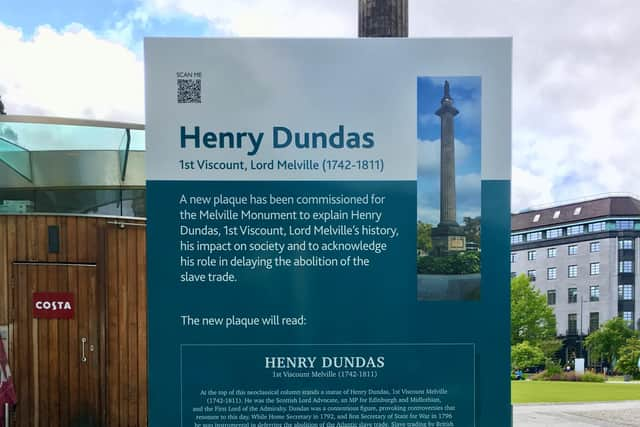New signs appear around Edinburgh's Melville Monument outlining Henry Dundas' involvement in the slave trade


Temporary signs outlining Henry Dundas’ involvement in the transatlantic slave trade have now been erected around the Melville Monument in St Andrew Square following a high-profile public debate.
The move comes following years of disagreement over how best to highlight the 18th century Edinburgh politician’s problematic past, as well as renewed public pressure for action after the death of George Floyd in the USA.
Advertisement
Hide AdAdvertisement
Hide AdThe signs will remain in place for the next six to eight weeks while a permanent plaque is created and goes through planning consent processes.
The signs read: “On the plinth at the centre of St Andrew Square stands a neoclassical column with a statue at the top. This represents Henry Dundas, 1st Viscount Melville (1742 – 1811). He was the Scottish Lord Advocate and an MP for Edinburgh and Midlothian, and the First Lord of the Admiralty.
“Dundas was a contentious figure, provoking controversies that resonate to this day. While Home Secretary in 1792 and first Secretary of State for War in 1796 he was instrumental in deferring the abolition of the Atlantic slave trade. Slave trading by British ships was not abolished until 1807. As a result of this delay, more than half a million enslaved Africans crossed the Atlantic. Dundas also curbed democratic dissent in Scotland.
“Dundas both defended and expanded the British empire, imposing colonial rule on indigenous peoples. He was impeached in the United Kingdom for misappropriation of public money and although acquitted, he never held public office again. Despite this, the monument before you to Henry Dundas was funded by voluntary contribution from officers, petty officers, seamen and marines and erected in 1821, with the statue placed on top in 1827.
Advertisement
Hide AdAdvertisement
Hide Ad“In 2020 this was dedicated to the memory of the more than half a million Africans whose enslavement was a consequence of Henry Dundas’s actions.”
Wording for the signs and plaque were put together at a meeting last month, comprising Council Leader Adam McVey, Depute Leader Cammy Day, Edinburgh World Heritage, Scotland’s first black professor Geoffrey Palmer and an expert from Edinburgh University.
Cllr McVey said: “It’s right that a more accurate description was agreed for the plaque at the statue of Henry Dundas and we were keen to act quickly.
“These temporary signs will be in place for the next 6-8 weeks while the permanent plaque is created and goes through the planning and listed building consent process.
Advertisement
Hide AdAdvertisement
Hide Ad“It’s important that a more appropriate and factual description is in place so that we can all get a better understanding of Edinburgh’s history, and particularly an honest acknowledgement of our City’s role in the slave trade.
“By more accurately reflecting our past we can more accurately accept our present and lingering racism which still haunts our society which must be stamped out. The voices of ethnic minority residents are key to that progress.”